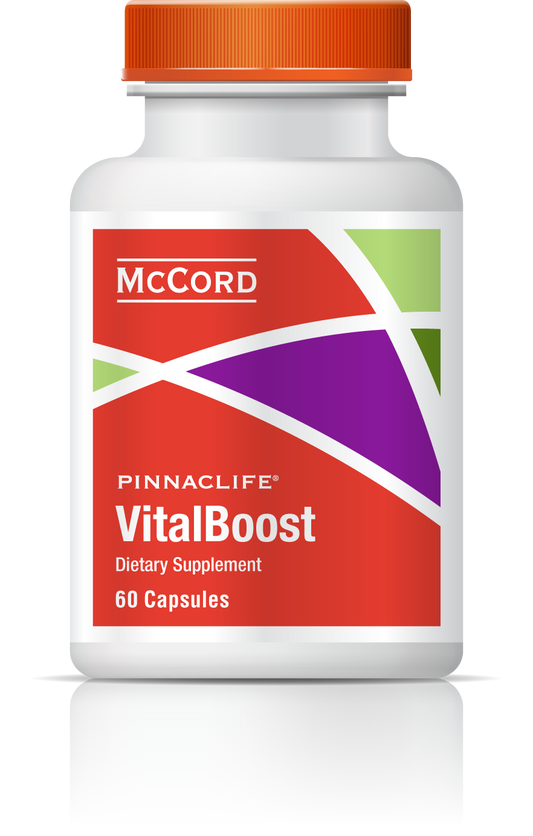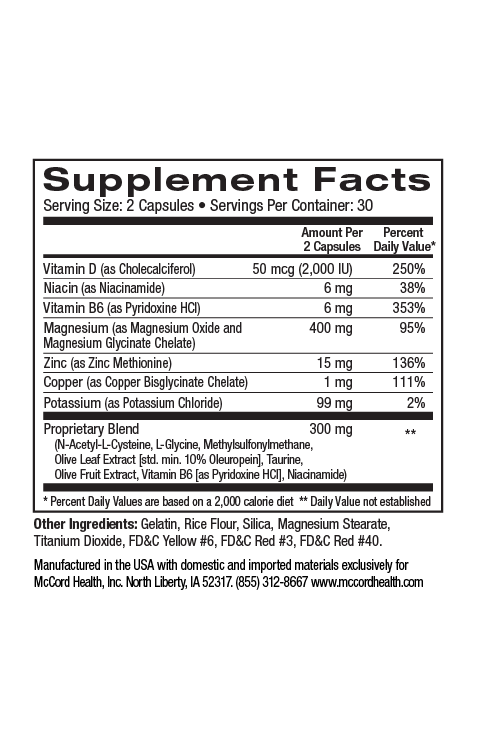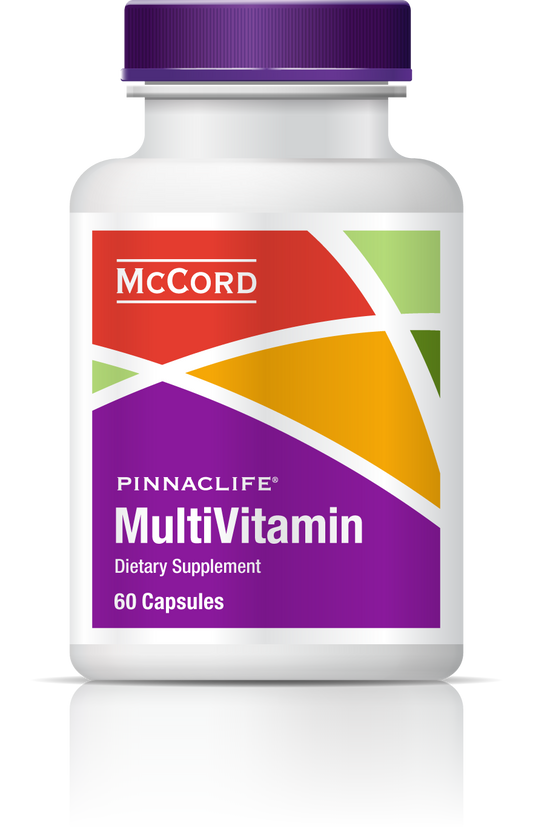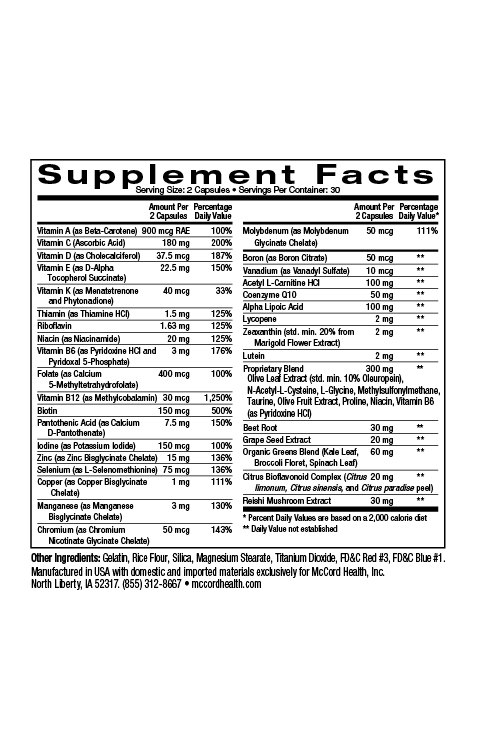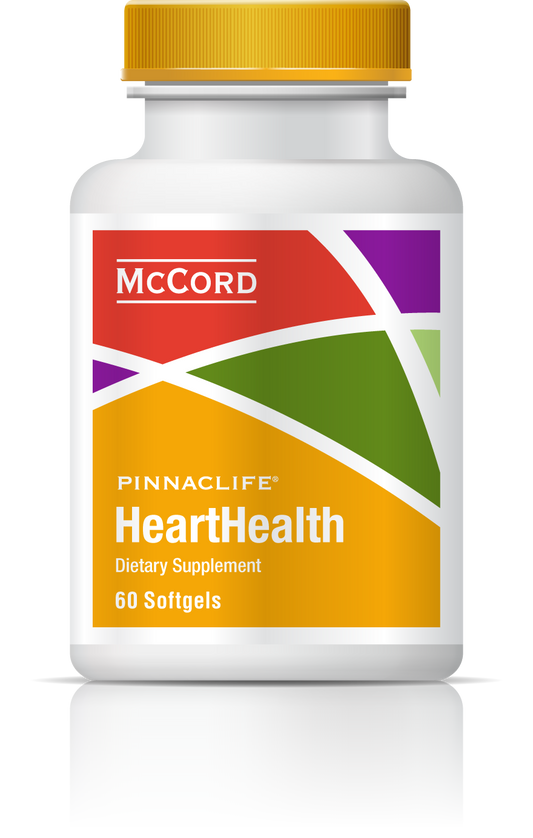The immune system protects us from pathogens, cancers and harmful substances. Some immune cells produce free radicals known as reactive oxygen species (ROS) to destroy invading cells. Antioxidants are required to regulate immune cell release of ROS and can help regulate immune responses. Oxidative stress that is typically associated with inflammation, occurs when free radicals overwhelm the balancing effects of the natural antioxidant defense system. Proprietary Blend includes ingredients with potent antioxidant and anti-inflammatory activities that can enhance protection against oxidative stress and inflammation to improve immune health.
- The immune system can distinguish between “self” and “non-self”
- Immune responses to “non-self” involve cells that produce free radicals
- Free radicals like reactive oxygens species (ROS) damage vital cellular structures and molecules in a process known as oxidation
- Oxidation of lipids and other ROS-induced effects can decrease immunity
- Antioxidants can protect against damage caused by ROS and reverse immune deficiencies
Our immune system protects us against foreign invasion by pathogens including viruses, bacteria and parasites, as well as harmful substances such as certain toxins. It is capable of discriminating between “self” and “non-self”, which also helps protect against altered cells within the body including cancer cells. The initial immune response involves immune cells like neutrophils and monocytes/macrophages that produce free radicals known as reactive oxygen species (ROS), which are capable of destroying invading pathogens and some tumor cells1,2.
Free radicals like ROS are unstable because they contain unpaired electrons resulting in their ability to steal electrons from other molecules in a process known as oxidation. Free radical damage can involve damage to cell membranes, DNA, proteins, lipids and organelles including mitochondria (known as cell powerhouses)3. Lipids are structurally similar to fats and include molecules like cholesterol. Oxidation of lipids, known as lipid peroxidation decreases cell membrane fluidity, which also decreases immunity since many immune cell defense responses depend on membrane fluidity. In fact, oxidized lipids can lead to immune cell dysfunction1,4.
Proprietary Blend Includes Potent Antioxidants
Various factors that cause increased ROS production can result in decreased immune responses such as aging, UV radiation (sunlight) exposure, and pollution including cigarette smoke1,4,5. Oxidative stress results from the inability of cells to eliminate ROS using the natural antioxidant defense system that includes defense enzymes like manganese superoxide dismutase (MnSOD)3. Potent antioxidants like hydroxytyrosol and oleuropein from olives, as well as N-acetylcysteine (NAC), taurine and methylsulfonylmethane (MSM)6-10 are key components of Proprietary Blend. Hydroxytyrosol, oleuropein and NAC have been shown to activate MnSOD11-13.
Because certain immune cells (as described previously) use ROS during a “respiratory burst” for defense against invading pathogens, it is critical for these cells to regulate the release of ROS. Antioxidants are absolutely required to regulate the reactions that release free radicals2,4. In addition, antioxidants improve immune functions related to protection against infections1,2. In fact, oleuropein was shown to promote specific immune reactions that are effective against the Lieshmania parasite, suggesting that oleuropein could be used as an immunomodulatory agent to improve therapies14.
Decreased regulation of immune responses can be associated with allergies and autoimmune diseases including rheumatoid arthritis that can involve increased inflammation. Immune cells known as mast cells play a significant role in allergies and inflammation that can have damaging effects15,17. Hydroxytyrosol and oleuropein were found to inhibit mast cell activation induced by immune responses16,17. Furthermore, hydroxtyrosol was shown to modulate an allergy-specific immune response in peripheral blood monocytes (PBMCs) by inducing a suppressive immune response (tolerance). Hydroxytyrosol has also been shown to inhibit inflammatory signal molecule secretion from macrophages18.
Antioxidants Can Improve Immune Functions
Oxidative stress is associated with inflammation; increased inflammation that occurs with aging is known as “inflammaging”19,20. Aging and chronic inflammation causes immune cells to be less effective, which can lead to increased infections and disease among older individuals15. In addition, aging individuals typically experience nutrient deficiencies21 and numerous studies have indicated that the development of tolerance and the regulation of inflammation may be altered by micronutrient deficiencies including antioxidant deficiencies2. In fact, supplementation with antioxidants can reverse age-associated immune deficiencies resulting in improved immune functions4.
The gut associated immune system is the most extensive immune system in the body. Interactions between the intestinal immune system and intestinal microbes are critical for intestinal barrier function and protection against infectious and inflammatory diseases. Evidence suggests that olive oil phenolic compounds including hydroxytyrosol and oleuropein can stimulate immune responses in the intestine including antibody responses against bacteria22. Olive oil polyphenols have also been shown to counteract proinflammatory effects of cholesterol oxidation-related compounds found in the diet23.
Proprietary Blend http://www.olivamine.com includes many ingredients with antioxidant and anti-inflammatory activities like hydroxytyrosol, oleuropein, NAC, taurine and MSM24-28. Proprietary Blend ImmuneHealth helps repair and regenerate immune cells to prevent immune dysfunction and deficiencies. ImmuneHealth includes impeccably sourced ingredients that have undergone rigorous scientific review to prove we renew, restore and repair cells.
References
- J Dairy Sci 1993; 76: 2789-2794.
- Curr Top Med Chem 2011; 11(14): 1752-1766.
- Curr Neuropharmacol 2009; 7: 65-74.
- Ann Clin Lab Sci 2000; 30(2): 145-158.
- Eur J Clin Nutr 2002; 56 (Suppl 3): 55-58.
- J Agric Food Chem 2011; 59: 4473-4482.
- Sci Pharm 2010; 78: 133-154.
- Amino Acids 2004; 26: 203-207.
- Nutrients 2017; 9(3): 290, 1-21.
- Life Sci 2015; 121: 110-116.
- J Biol Regul Homeost Agents 2014; 28: 105-116.
- Age 2012; 34: 95-109.
- Cancer Res 2007; 67: 6392-6399.
- Parasites Vectors 2016; 9: 441: 1-16.
- Nutr J 2008; 7: 29: 1-9.
- Food Funct 2016; 7: 4492-4505.
- Endocr Metab Immune Disord Drug Targets 2018; 18(1): 1-9.
- Immunobiol 2016; 221: 1374-1377.
- Oxid Med Cell Longev 2016; ID7432797, 1-9.
- Nat Rev Endocrinol 2018; 14: 576-590.
- J Nutr Sci 2017; 6: e2.
- Nutrients 2016; 8: 213: 1-14.
- Mol Nutr Food Res 2017; 61: 1700283, 1-7.
- Planta Med 2011; 77: 1890-1897.
- Int J Mol Sci 2014; 15: 18508-18524.
- World J Diabetes 2014; 5: 679-710.
- Biol Pharm Bull 2009; 32: 651-656.
- Amino Acids 1996; 10: 59-71.

